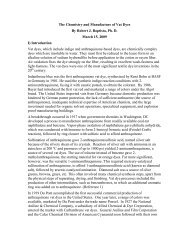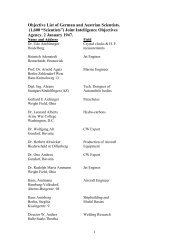International Dyestuff Industry - ColorantsHistory.Org
International Dyestuff Industry - ColorantsHistory.Org
International Dyestuff Industry - ColorantsHistory.Org
Create successful ePaper yourself
Turn your PDF publications into a flip-book with our unique Google optimized e-Paper software.
Success in resolving the scientific puzzle came from Switzerland where routes from more<br />
abundant starting materials were found, In 1890, Karl Heumann at the Zurich Federal<br />
Polytechnic (ETH), found that aniline and naphthalene were possible starting materials. The<br />
aniline process used benzene; the naphthalene route was via its conversion to phthalic<br />
anhydride, and then into a derivative of phenylglycine. Rudolph Knietsch undertook<br />
research into indigo for CIBA in Basel and then joined the BASF effort. These events<br />
became critical to the success of BASF.<br />
In July l897,using the naphthalene process, BASF began to market synthetic indigo. This<br />
was based on the economical oxidation of naphthalene to phthalic anhydride with fuming<br />
sulfuric acid and mercury. Sulfur dioxide was evolved and recovered for conversion back<br />
into fuming acid by the contact process, developed on a large scale by Knietsch. BASF also<br />
undertook the then novel electrochemical production of chlorine and alkali, essential<br />
inorganic chemicals in the indigo synthesis.<br />
The new product however, could only just compete with the natural colorant. BASF were<br />
confident that synthetic indigo would win out if the quality was good. They were proved<br />
right. The synthetic product began to make rapid headway once it was found to be easy to<br />
apply, and that, like synthetic alizarin in the 1870s, the color was consistent. From the turn<br />
of the century German indigo began to displace Indian indigo, much to the concern of the<br />
British planters and traders. BASF and Hoechst had set up manufacturing units in France at<br />
Villeneuve St. Georges and Creil, respectively and Hoechst opened an indigo factory in<br />
Britain at Ellesmere Port.<br />
Swiss attempts to make synthetic indigo on a large scale were partially successful.<br />
Sandmeyer’s process was revived in an improved form by Rathien of Hamburg during 1910,<br />
and in the same year von Heyden of Dresden commenced manufacture by the<br />
phenylglycine route.<br />
1900-1914<br />
The dye industry before the First World War. The strength of the German industry.<br />
The German influence over world markets became so great that practically every country<br />
imported German dyes, including major consumers in the Far East, like China and Japan.<br />
This was assisted by an increasing reliance on cartels and the introduction of new products.<br />
In 1900, under pressure from the Germans, the Alizarine Convention was revived. During<br />
1901, Rene Bohn at BASF developed the fast yellow known as flavanthrone, followed by the<br />
blue indanthrone. These novel vat dyes, made from anthraquinone used in the alizarin<br />
process, were in demand worldwide, and were joined by Bayer and Hoechst versions (they<br />
became known as indanthren dyes).<br />
The triumph of the indigo synthesis foreshadowed the end of natural dyestuffs as a major<br />
economic force. The remaining processors of indigo, dyewoods and vegetable colors were<br />
forced to merge in order to survive. In Britain the British Dyewood Chemical Company was<br />
formed in Glasgow in 1898 (in 1911 it was restructured as a limited company under the<br />
ownership of United Dye Corporation of New Jersey; it was acquired by British interests in<br />
1927, and survived until 1980); the United Indigo & Chemical Co. in 1899; and the<br />
Yorkshire Dyeware & Chemical Co. in 1900. [45] United Indigo & Chemical Co. was a<br />
merger of Scottish, Lancashire and Yorkshire interests involved in the manufacture of<br />
natural indigo and dyewood products.<br />
Until the 1920s and beyond, haematein from logwood was used on wool in large amounts,<br />
fustic was a popular yellow for mixed shades, and natural indigo was often preferred on<br />
woolens for dark blues. Most of the logwoods exported from Haiti were bound for United<br />
States ports.<br />
Shortly after the turn of the century the Germans formed communities of interests,<br />
powerful associations of firms that became more closely linked than in monopolies, but were<br />
not mergers. This helped maintain strength through agreements over prices and the<br />
amounts of various products individual members could produce. In 1904, Hoechst joined<br />
with Cassella of Frankfurt to form the double alliance, and Bayer, BASF and AGFA linked up<br />
to create the triple alliance, or Dreibund, also known as the Little IG. In the same year, the<br />
United States imported 20 per cent of German dyestuff production, more than any other





